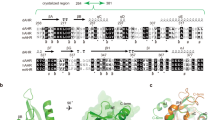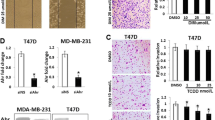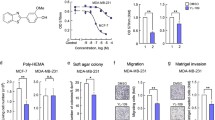Abstract
The aryl hydrocarbon receptor (AhR) is a ligand-activated transcription factor and a member of the bHLH/PAS (basic Helix-Loop-Helix/Per-Arnt-Sim) family of proteins. The AhR was cloned and characterized for its role in mediating the toxicity of dioxins. Subsequent research has identified the role of AhR in suppression of cancer cell growth. We hypothesized that the AhR is a molecular target for therapeutic intervention in cancer, and that activation of the AhR by unique AhR ligands in cancer cells could have anti-cancer effects including induction of cell death. This study describes the discovery and characterization of a new class of anti-cancer agents targeting the AhR, that we designate as Select Modulators of AhR-regulated Transcription (SMAhRTs). We employed two independent small molecule screening approaches to identify potential SMAhRTs. We report the identification of CGS-15943 that activates AhR signaling and induces apoptosis in an AhR-dependent manner in liver and breast cancer cells. Investigation of the downstream signaling pathway of this newly identified SMAhRT revealed upregulation of Fas-ligand (FasL), which is required for AhR-mediated apoptosis. Our results provide a basis for further development of a new class of anti-cancer therapeutics targeting an underappreciated molecular target, the AhR.







Similar content being viewed by others
Abbreviations
- AhR:
-
Aryl hydrocarbon Receptor
- Arnt:
-
Aryl Hydrocarbon Receptor Nuclear Translocator
- bHLH-PAS:
-
Basichelix-loop-helix-Per/Arnt/Sim
- DBD:
-
DNA-binding domain
- DEN:
-
Diethylnitrosamine
- DMBA:
-
7,12-Dimethylbenz[a]anthracene
- FICZ:
-
6-Formylindolo[3,2-b]carbazole
- HSCs:
-
Hematopoietic stem cells
- ITE:
-
2-(1'H-indole-3'-carbonyl)-thiazole-4-carboxylic acid methyl ester
- NQO1:
-
NADPH: quinone oxidoreductase
- SMAhRTs:
-
Select modulators of AhR-regulated transcription
- TRAMP:
-
Transgenic adenocarcinoma of the mouse prostate
References
Kolluri SK, Jin UH, Safe S (2017) Role of the aryl hydrocarbon receptor in carcinogenesis and potential as an anti-cancer drug target. Arch Toxicol 91:2497–2513
Pollenz RS, Sattler CA, Poland A (1994) The aryl hydrocarbon receptor and aryl hydrocarbon receptor nuclear translocator protein show distinct subcellular localizations in Hepa 1c1c7 cells by immunofluorescence microscopy. Mol Pharmacol 45(3):428–438
Perdew GH (1988) Association of the Ah receptor with the 90-kDa heat shock protein. J Biol Chem 263(27):13802–13805
Nair SC, Toran EJ, Rimerman RA, Hjermstad S, Smithgall TE, Smith DF (1996) A pathway of multi-chaperone interactions common to diverse regulatory proteins: estrogen receptor, Fes tyrosine kinase, heat shock transcription factor Hsf1, and the aryl hydrocarbon receptor. Cell Stress Chaperones 1(4):237–250
Kazlauskas A, Poellinger L, Pongratz I (1999) Evidence that the co-chaperone p23 regulates ligand responsiveness of the dioxin (Aryl hydrocarbon) receptor. J Biol Chem 274(19):13519–13524
Hord NG, Perdew GH (1994) Physicochemical and immunocytochemical analysis of the aryl hydrocarbon receptor nuclear translocator: characterization of two monoclonal antibodies to the aryl hydrocarbon receptor nuclear translocator. Mol Pharmacol 46(4):618–626
Fernandez-Salguero PM, Hilbert DM, Rudikoff S, Ward JM, Gonzalez FJ (1996) Aryl-hydrocarbon receptor-deficient mice are resistant to 2,3,7,8-tetrachlorodibenzo-p-dioxin-induced toxicity. Toxicol Appl Pharmacol 140(1):173–179
Marlowe JL, Puga A (2005) Aryl hydrocarbon receptor, cell cycle regulation, toxicity, and tumorigenesis. J Cell Biochem 96(6):1174–1184
Weiss C, Kolluri SK, Kiefer F, Göttlicher M (1996) Complementation of Ah receptor deficiency in hepatoma cells: negative feedback regulation and cell cycle control by the Ah receptor. Exp Cell Res 226(1):154–163
Kolluri SK, Weiss C, Koff A, Gottlicher M (1999) p27(Kip1) induction and inhibition of proliferation by the intracellular Ah receptor in developing thymus and hepatoma cells. Genes Dev 13(13):1742–1753
Jin UH, Karki K, Cheng Y, Michelhaugh SK, Mittal S, Safe S (2019) The aryl hydrocarbon receptor is a tumor suppressor-like gene in glioblastoma. J Biol Chem 294(29):11342–11353
Fan Y, Boivin GP, Knudsen ES, Nebert DW, Xia Y, Puga A (2010) The aryl hydrocarbon receptor functions as a tumor suppressor of liver carcinogenesis. Cancer Res 70(1):212–220
Fritz WA, Lin TM, Cardiff RD, Peterson RE (2007) The aryl hydrocarbon receptor inhibits prostate carcinogenesis in TRAMP mice. Carcinogenesis 28(2):497–505
Kawakami T, Ito T, Ohsako S, Shiizaki K, Murakami Y, Hirowatari K, Sato M, Tohyama C (2009) Possible involvement of arylhydrocarbon receptor variants in TCDD-induced thymic atrophy and XRE-dependent transcriptional activity in Wistar Hannover GALAS rats. J Toxicol Sci 34(2):209–220
Denison MS, Nagy SR (2003) Activation of the aryl hydrocarbon receptor by structurally diverse exogenous and endogenous chemicals. Annu Rev Pharmacol Toxicol 43:309–334
Ehrlich AK, Pennington JM, Wang X, Rohlman D, Punj S, Löhr CV, Newman MT, Kolluri SK, Kerkvliet NI (2016) Activation of the aryl hydrocarbon receptor by 10-Cl-BBQ prevents insulitis and effector T cell development independently of Foxp3+ regulatory T cells in nonobese diabetic mice. J Immunol 196(1):264–273
Boitano AE, Wang J, Romeo R, Bouchez LC, Parker AE, Sutton SE, Walker JR, Flaveny CA, Perdew GH, Denison MS, Schultz PG, Cooke MP (2010) Aryl hydrocarbon receptor antagonists promote the expansion of human hematopoietic stem cells. Science 329(5997):1345–1348
Wagner JE Jr, Brunstein CG, Boitano AE, DeFor TE, McKenna D, Sumstad D, Blazar BR, Tolar J, Le C, Jones J, Cooke MP, Bleul CC (2016) Phase I/II trial of StemRegenin-1 expanded umbilical cord blood hematopoietic stem cells supports testing as a stand-alone graft. Cell Stem Cell 18(1):144–155
Hu W, Sorrentino C, Denison MS, Kolaja K, Fielden MR (2007) Induction of cyp1a1 is a nonspecific biomarker of aryl hydrocarbon receptor activation: results of large scale screening of pharmaceuticals and toxicants in vivo and in vitro. Mol Pharmacol 71(6):1475–1486
O’Donnell EF, Saili KS, Koch DC, Kopparapu PR, Farrer D, Bisson WH, Mathew LK, Sengupta S, Kerkvliet NI, Tanguay RL, Kolluri SK (2010) The anti-inflammatory drug leflunomide is an agonist of the aryl hydrocarbon receptor. PLoS ONE 5(10):e13128. https://doi.org/10.1371/journal.pone.0013128
O’Donnell EF, Kopparapu PR, Koch DC, Jang HS, Phillips JL, Tanguay RL, Kerkvliet NI, Kolluri SK (2012) The aryl hydrocarbon receptor mediates leflunomide-induced growth inhibition of melanoma cells. PLoS ONE 7(7):e40926
Koch DC, Jang HS, O’Donnell EF, Punj S, Kopparapu PR, Bisson WH, Kerkvliet NI, Kolluri SK (2015) Anti-androgen flutamide suppresses hepatocellular carcinoma cell proliferation via the aryl hydrocarbon receptor mediated induction of transforming growth factor-beta1. Oncogene 34(50):6092–6104
O’Donnell EF, Koch DC, Bisson WH, Jang HS, Kolluri SK (2014) The aryl hydrocarbon receptor mediates raloxifene-induced apoptosis in estrogen receptor-negative hepatoma and breast cancer cells. Cell Death Dis 5:e1038
Nothdurft S, Thumser-Henner C, Breitenbücher F, Okimoto RA, Dorsch M, Opitz CA, Sadik A, Esser C, Hölzel M, Asthana S, Forster J, Beisser D, Kalmbach S, Grüner BM, Bivona TG, Schramm A, Schuler M (2020) Functional screening identifies aryl hydrocarbon receptor as suppressor of lung cancer metastasis. Oncogenesis 9(11):102
Williams M, Francis J, Ghai G, Braunwalder A, Psychoyos S, Stone GA, Cash WD (1987) Biochemical characterization of the triazoloquinazoline, CGS-15943, a novel, non-xanthine adenosine antagonist. J Pharmacol Exp Ther 241(2):415–420
Han D, Nagy SR, Denison MS (2004) Comparison of recombinant cell bioassays for the detection of Ah receptor agonists. BioFactors 20(1):11–22
Henry EC, Gasiewicz TA (2003) Agonist but not antagonist ligands induce conformational change in the mouse aryl hydrocarbon receptor as detected by partial proteolysis. Mol Pharmacol 63(2):392–400
Punj S, Kopparapu P, Jang HS, Phillips JL, Pennington J, Rohlman D, O’Donnell E, Iversen PL, Kolluri SK, Kerkvliet NI (2014) Benzimidazoisoquinolines: a new class of rapidly metabolized aryl hydrocarbon receptor (AhR) ligands that induce AhR-dependent Tregs and prevent murine graft-versus-host disease. PLoS ONE 9(2):e88726
Matikainen T, Perez GI, Jurisicova A, Pru JK, Schlezinger JJ, Ryu HY, Laine J, Sakai T, Korsmeyer SJ, Casper RF, Sherr DH, Tilly JL (2001) Aromatic hydrocarbon receptor-driven Bax gene expression is required for premature ovarian failure caused by biohazardous environmental chemicals. Nat Genet 28(4):355–360
Matikainen TM, Moriyama T, Morita Y, Perez GI, Korsmeyer SJ, Sherr DH, Tilly JL (2002) Ligand activation of the aromatic hydrocarbon receptor transcription factor drives Bax-dependent apoptosis in developing fetal ovarian germ cells. Endocrinology 143(2):615–620
DeGroot DE, Hayashi A, Denison MS (2014) Lack of ligand-selective binding of the aryl hydrocarbon receptor to putative DNA binding sites regulating expression of Bax and paraoxonase 1 genes. Arch Biochem Biophys 541:13–20
Scaffidi C, Fulda S, Srinivasan A, Friesen C, Li F, Tomaselli KJ, Debatin KM, Krammer PH, Peter ME (1998) Two CD95 (APO-1/Fas) signaling pathways. EMBO J 17(6):1675–1687
Scaffidi C, Schmitz I, Zha J, Korsmeyer SJ, Krammer PH, Peter ME (1999) Differential modulation of apoptosis sensitivity in CD95 type I and type II cells. J Biol Chem 274(32):22532–22538
Sanchez-Martin FJ, Fernandez-Salguero PM, Merino JM (2011) Aryl hydrocarbon receptor-dependent induction of apoptosis by 2,3,7,8-tetrachlorodibenzo-p-dioxin in cerebellar granule cells from mouse. J Neurochem 118(1):153–162
Morales-Hernandez A, Sanchez-Martin FJ, Hortigon-Vinagre MP, Henao F, Merino JM (2012) 2,3,7,8-Tetrachlorodibenzo-p-dioxin induces apoptosis by disruption of intracellular calcium homeostasis in human neuronal cell line SHSY5Y. Apoptosis 17(11):1170–1181
Ito T, Tsukumo S, Suzuki N, Motohashi H, Yamamoto M, Fujii-Kuriyama Y, Mimura J, Lin TM, Peterson RE, Tohyama C, Nohara K (2004) A constitutively active arylhydrocarbon receptor induces growth inhibition of jurkat T cells through changes in the expression of genes related to apoptosis and cell cycle arrest. J Biol Chem 279(24):25204–25210
Nohara K, Pan X, Tsukumo S, Hida A, Ito T, Nagai H, Inouye K, Motohashi H, Yamamoto M, Fujii-Kuriyama Y, Tohyama C (2005) Constitutively active aryl hydrocarbon receptor expressed specifically in T-lineage cells causes thymus involution and suppresses the immunization-induced increase in splenocytes. J Immunol 174(5):2770–2777
Nagai H, Kubo M, Abe R, Yamamoto M, Nohara K (2006) Constitutive activation of the aryl hydrocarbon receptor in T-lineage cells induces thymus involution independently of the Fas/Fas ligand signaling pathway. Int Immunopharmacol 6(2):279–286
Zeytun A, McKallip RJ, Fisher M, Camacho I, Nagarkatti M, Nagarkatti PS (2002) Analysis of 2,3,7,8-tetrachlorodibenzo-p-dioxin-induced gene expression profile in vivo using pathway-specific cDNA arrays. Toxicology 178(3):241–260
Camacho IA, Nagarkatti M, Nagarkatti PS (2002) 2,3,7,8-Tetrachlorodibenzo-p-dioxin (TCDD) induces Fas-dependent activation-induced cell death in superantigen-primed T cells. Arch Toxicol 76(10):570–580
Singh NP, Nagarkatti M, Nagarkatti PS (2007) Role of dioxin response element and nuclear factor-kappaB motifs in 2,3,7,8-tetrachlorodibenzo-p-dioxin-mediated regulation of Fas and Fas ligand expression. Mol Pharmacol 71(1):145–157
Tamura K, Kanno T, Fujita Y, Gotoh A, Nakano T, Nishizaki T (2012) A(2a) adenosine receptor mediates HepG2 cell apoptosis by downregulating Bcl-X(L) expression and upregulating Bid expression. J Cell Biochem 113(5):1766–1775
Wu LF, Li GP, Feng JL, Pu ZJ (2006) Molecular mechanisms of adenosine-induced apoptosis in human HepG2 cells. Acta Pharmacol Sin 27(4):477–484
Denison MS, Rogers JM, Rushing SR, Jones CL, Tetangco SC and Heath-Pagliuso S. Analysis of the aryl hydrocarbon receptor (AhR) signal transduction pathway. Curr Protoc Toxicol. 2002; Chapter 4: Unit4 8.
Kolluri SK, Zhu X, Zhou X, Lin B, Chen Y, Sun K, Tian X, Town J, Cao X, Lin F, Zhai D, Kitada S, Luciano F, O’Donnell E, Cao Y, He F et al (2008) A short Nur77-derived peptide converts Bcl-2 from a protector to a killer. Cancer Cell 14(4):285–298
Garrison PM, Tullis K, Aarts JM, Brouwer A, Giesy JP, Denison MS (1996) Species-specific recombinant cell lines as bioassay systems for the detection of 2,3,7,8-tetrachlorodibenzo-p-dioxin-like chemicals. Fundam Appl Toxicol 30(2):194–203
Murk AJ, Legler J, Denison MS, Giesy JP, van de Guchte C, Brouwer A (1996) Chemical-activated luciferase gene expression (CALUX): a novel in vitro bioassay for Ah receptor active compounds in sediments and pore water. Fundam Appl Toxicol 33(1):149–160
Han H, Davidson LA, Fan YY, Goldsby JS, Yoon G, Jin UH, Wright GA, Landrock KK, Weeks BR, Wright RC, Allred CD, Jayaraman A, Ivanov I, Roper J, Safe SH, Chapkin RS (2020) Loss of aryl hydrocarbon receptor potentiates FoxM1 signaling to enhance self-renewal of colonic stem and progenitor cells. EMBO J 39(19):e104319
Han H, Davidson LA, Hensel M, Yoon G, Landrock K, Allred C, Jayaraman A, Ivanov I, Safe SH, Chapkin RS (2021) Loss of aryl hydrocarbon receptor promotes colon tumorigenesis in ApcS580/+; KrasG12D/+ mice. Mol Cancer Res. https://doi.org/10.1158/1541-7786.MCR-20-0789
Rowland LK, Campbell PS, Mavingire N, Wooten JV, McLean L, Zylstra D, Thorne G, Daly D, Boyle K, Whang S, Unternaehrer J, Brantley EJ (2019) Putative tumor suppressor cytoglobin promotes aryl hydrocarbon receptor ligand-mediated triple negative breast cancer cell death. J Cell Biochem 120(4):6004–6014
Jang HS, Pearce M, O’Donnell EF, Nguyen BD, Truong L, Mueller MJ, Bisson WH, Kerkvliet NI, Tanguay RL, Kolluri SK (2017) Identification of a raloxifene analog that promotes AhR-mediated apoptosis in cancer cells. Biology (Basel). 6(4):E41. https://doi.org/10.3390/biology6040041
O’Donnell EF, Jang HS, Pearce M, Kerkvliet NI, Kolluri SK (2017) The aryl hydrocarbon receptor is required for induction of p21cip1/waf1 expression and growth inhibition by SU5416 in hepatoma cells. Oncotarget 8(15):25211–25225
Acknowledgments
The authors wish to thank Samuel Bradford for excellent technical assistance with flow cytometry and Kyla Guertin for excellent laboratory assistance.
Funding
This work was supported by the American Cancer Society (RSG-13-132-01-CDD) and in part by National Institute of Environmental Health Sciences (NIEHS) grant numbers ES016651, ES019000, P30 ES030287 and The US Army Medical Research and Material Command. EFO was supported by pre-doctoral fellowships from NIEHS training grant (T32 ES007060) and the Department of Defense Breast Cancer Research Program (W81XWH-10-1-0160). DFL was supported by NIEHS training grant (T32 ES007060), Diversity advancement pipeline fellowship (Oregon State University), P.F. Yerex and Nellie Buck graduate fellowship (Oregon State University), and the National Research Service Award (1F31CA144571) from the National Cancer Institute.
Author information
Authors and Affiliations
Contributions
EFO contributed to study design, execution of experiments, data analysis, and wrote the manuscript. HSJ performed experiments and contributed to data analysis. DCK performed experiments, contributed to data analysis, and provided input on study design. NIK provided input on study design and provided material support. SKK designed and supervised the study, and helped prepare and revise the manuscript.
Corresponding author
Ethics declarations
Conflict of interests
The authors have no conflict of interests to disclose.
Additional information
Publisher's Note
Springer Nature remains neutral with regard to jurisdictional claims in published maps and institutional affiliations.
Supplementary Information
Below is the link to the electronic supplementary material.
Supplementary file2 (MOV 15857 kb)
Supplementary file3 (MOV 80759 kb)
Supplementary file4 (MOV 88487 kb)
Supplementary file5 (MOV 32294 kb)
Rights and permissions
About this article
Cite this article
O’Donnell, E.F., Jang, H.S., Liefwalker, D.F. et al. Discovery and Mechanistic Characterization of a Select Modulator of AhR-regulated Transcription (SMAhRT) with Anti-cancer Effects. Apoptosis 26, 307–322 (2021). https://doi.org/10.1007/s10495-021-01666-0
Accepted:
Published:
Issue Date:
DOI: https://doi.org/10.1007/s10495-021-01666-0




